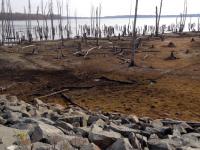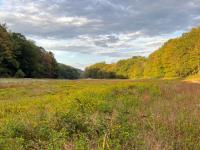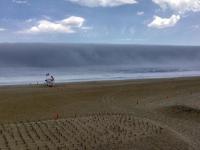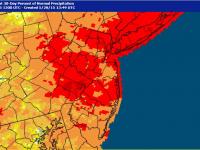
About 70% of the fresh water used around the world is devoted to irrigation, and a similar figure holds true with respect to New Jersey’s water use. Much of this in New Jersey is put towards lawn watering. It is apparent to anyone paying attention to the frequency and timing of when lawns are watered that, just as research suggests, many New Jersey homeowners are over-irrigating their lawns. This wastes precious water that could be conserved wisely by employing more efficient irrigation methods. This article outlines a simple way that you can participate in our New Jersey Smart Lawn Watering Initiative without investing in new sprinkler equipment or devoting large amounts of time to lawn management. By following the instructions discussed below, you can save water and money, while keeping your lawn green and beautiful.
Studies have shown that lawns can grow as well, if not better, with less water than is delivered to them through common manual and automated irrigation practices. This, in part, is because many grasses are drought resistant when left on their own. Relying on deficit irrigation (giving lawns less water less often) prompts grasses to develop deeper and more complex root systems. One benefit of this root growth is that grasses will stay healthy during water shortages when mandatory restrictions on water use may be in place. Applying less water to your lawn can also minimize nutrient losses through processes like nitrogen leaching that commonly occur in soil. Reduced nutrient losses can lead to healthier soil, which in turn, helps to cultivate and maintain a healthier, greener lawn!
Improving your lawn watering habits involves keeping track of evapotranspiration and precipitation values for your area. Evapotranspiration (ET) refers to the combination of evaporation of water from the earth’s surface and transpiration, which is the release of water into the atmosphere via plants. The basic relationship between evapotranspiration and precipitation that should be applied to lawn watering in New Jersey is as follows: for 0.25 inch of evapotranspiration without an equal amount of rainfall, lawns should be irrigated for about 15 minutes. However, do not use this relationship to water on a daily basis! Read on for the proper way to apply this relationship to your lawn.
Due to different soils and, consequently, properties governing water infiltration and runoff rates, the type of soil must be considered when scheduling irrigation. In areas with loamy soils, this rainfall-ET-watering relationship should be applied on a 4-day plan, while in areas with sandy soils (like coastal New Jersey) this relationship should run on a 3-day cycle (soils simply dry out faster where they are sandy). Thus, irrigation events (if needed) are spaced out by 3 to 4 days and water should not be applied to your lawn more frequently. The amount of time that water is applied during a watering event depends on sprinkler type and water pressure, but a good guide is that 15 minutes of watering is roughly equal to 0.25 inch of water applied to your lawn. During cooler months (October–March), evapotranspiration rates are quite low and thus lawn watering is rarely necessary.
Now that you have been introduced to the general relationship, how can it be applied to determine when and for how long you should water your lawn? To start off, let’s assume a summer evapotranspiration value of 0.20 inch per day for the entirety of the state. This will vary due to weather conditions, and is best representative of warm days with low humidity, but let’s keep it simple and err on the high side, just to make sure your watering will suffice. So unless you want to take things a step further and raise the values to 0.25 inch on a particularly warm, dry day or decrease it to something between 0.05 inch and 0.15 inch on a cloudy or rainy day, just always use 0.20 inch The 0.20 inch value will be assumed in the rest of this discussion. Using the previously-defined relationship for evapotranspiration and precipitation, your lawn should receive about 0.80 inch of water via rainfall and/or irrigation every 3 to 4 days. One easy way to determine how much precipitation has fallen in your area for a given watering cycle is to check local precipitation maps like those found here and here to track how much rain fell in your area each day. You can also purchase an inexpensive rain gauge and measure precipitation on your own! If you receive 0.80 inch or more of precipitation during that time period, no water should be applied to your lawn on the morning following the 4-day time period and the cycle should start over, recording cumulative precipitation values once again for the next 4-day time period. For instance, if you receive a total of 0.50 inch of precipitation during a 4-day cycle, your lawn will need 0.30 inch of water (about 18 minutes of watering) once the cycle ends (you may want to simply water to the closest 15 minute increment; don’t worry about exact timing). Thus, watering needs will be fulfilled for this interval through both natural processes and irrigation. Precipitation and irrigation values counted for one cycle should not be carried over to the next cycle, as each 3 to 4 day time period should be considered separately. Below is an example over four watering cycles (16 days) to show how this approach works.
Example irrigation schedule spanning 16 days for an area with loamy soils:
Cycle 1:
Day 1: Evapotranspiration is 0.20 inch; Rainfall is 0.00 inch
Day 2: Evapotranspiration is 0.20 inch; Rainfall is 0.00 inch
Day 3: Evapotranspiration is 0.20 inch; Rainfall is 0.25 inch
Day 4: Evapotranspiration is 0.20 inch; Rainfall is 0.00 inch
Since rainfall was 0.25 inch and evapotranspiration was 0.80 inch, on the morning of the following day (day 1 of the next 4-day cycle, which is day 5 in this 16-day example), the lawn should be watered for 33 minutes to apply about 0.55 inch of water. Together, with precipitation, this will amount to the 0.80 inch of water that your lawn needs to thrive. This will start a new 4-day cycle and these values will not be considered further.
Cycle 2:
Day 5: Evapotranspiration is 0.20 inch; Rainfall is 0.00 inch
Day 6: Evapotranspiration is 0.20 inch; Rainfall is 0.00 inch
Day 7: Evapotranspiration is 0.20 inch; Rainfall is 0.00 inch
Day 8: Evapotranspiration is 0.20 inch; Rainfall is 0.00 inch
Since rainfall was 0.00 inch and evapotranspiration was 0.80 inch, on the morning of the following day (day 1 of the next 4-day cycle, which is day 9 in this 16-day example), the lawn should be watered for 48 minutes. This will apply 0.80 inch of water to the lawn and start a new 4-day cycle.
Cycle 3:
Day 9: Evapotranspiration is 0.20 inch; Rainfall is 0.00 inch
Day 10: Evapotranspiration is 0.20 inch; Rainfall is 0.00 inch
Day 11: Evapotranspiration is 0.20 inch; Rainfall is 2.15 inch
Day 12: Evapotranspiration is 0.20 inch; Rainfall is 0.00 inch
Since rainfall was 2.15 inch, far exceeding the necessary 0.80 inch of precipitation for this 4-day cycle, no watering is necessary for the lawn on the morning of the following day (day 1 of the next 4-day cycle, which is day 13 in this 16-day example). This is the start of the next 4-day cycle.
Cycle 4:
Day 13: Evapotranspiration is 0.20 inch; Rainfall is 0.00 inch
Day 14: Evapotranspiration is 0.20 inch; Rainfall is 0.00 inch
Day 15: Evapotranspiration is 0.20 inch; Rainfall is 0.00 inch
Day 16: Evapotranspiration is 0.20 inch; Rainfall is 0.50 inch
Since rainfall was 0.50 inch and evapotranspiration was 0.80 inch for this 4-day cycle, the lawn should be watered for 18 minutes to apply 0.30 inch of water on the morning of the following day (day 1 of the next cycle).
Following this practice should save money, water, and even time if you have been watering too frequently, while improving the quality of your lawn. If you think this through a bit further you can even do more to ensure a healthy lawn while conserving water. The method we have proposed relies on general estimations. Your area may experience evapotranspiration rates that differ from the estimated 0.20 inch per day, you may receive considerably more than 0.80 inch of rainfall over the 3 or 4 day cycle (enough that you believe you could extend the cycle length), or you may believe your sprinkler is not delivering enough water to achieve the watering rate assumed in the examples here. Purchasing a rain gauge to pinpoint the exact precipitation value is helpful. The standard ET rate can be adjusted if you judge the 3- or 4-day cycle was quite cloudy and cool (lowering ET) or hot with very dry air (raising ET).
An easy way to prevent over- or under-watering in these situations is to simply look at your lawn. If the grass does not “bounce back” after being stepped on or appears wilted, it is time to water! You can also switch your garden to plants that are native to your part of the state or plants that generally require less water. This will create a sustainable alternative for the typical home garden.
Calculating the uniformity and output rate of your sprinkler system can help you to more accurately apply the needed amount of water. While we suggest 15-minute increments based on a general knowledge of regional water pressure and sprinkler characteristics, a better estimate of necessary watering duration (which can further enhance water conservation) can be achieved by more accurate knowledge of how much water your sprinkler distributes per unit time. This can be done by placing cylindrical cans (something as simple as tuna cans) around your lawn and measuring the water that falls into each over a timed watering interval. Also, increasing the height of your lawn mower blade has been shown to save water by reducing grass stress. Finally, it is best to water during the early morning hours when ET rates are lowest (so the water will best infiltrate the soil) and wind speeds tend to be low (so water does not evaporate before it hits the lawn and it better hits its intended target).
If you wish to learn more about how to have a water efficient lawn, check out the websites below to see what other organizations are doing to conserve water with more sustainable lawn care and gardening systems.
Daily Evapotranspiration and Irrigation Scheduling from United Water
Do-it-yourself Guide to Water-Efficient Lawn Care
Economic and Environmental Benefits of Conserving Water
WaterSense Program from the EPA
Measuring Sprinkler Uniformity
CoCoRaHS Observations
Suggested reading for those interested in learning more:
Cardenas-Lailhacar, B., Dukes, M.D., and Miller, G.L., 2008, Sensor-Based Automation of Irrigation on Bermudagrass, during Wet Weather Conditions: Journal of Irrigation & Drainage Engineering, v. 134, p. 120-128, doi: 10.1061/(ASCE)0733-9437(2008)134:2(120).
http://abe.ufl.edu/mdukes/pdf/publications/SMS/Cardenas-SMS-paper-JID.pdf
Davis, S.L., Dukes, M.D., and Miller, G.L., 2009, Landscape irrigation by evapotranspiration-based irrigation controllers under dry conditions in Southwest Florida: Agricultural Water Management, v. 96, p. 1828-1836, doi: http://dx.doi.org/10.1016/j.agwat.2009.08.005.
Devitt, D.A., Carstensen, K., and Morris, R.L., 2008, Residential Water Savings Associated with Satellite-Based ET Irrigation Controllers: Journal of Irrigation & Drainage Engineering, v. 134, p. 74-82, doi: 10.1061/(ASCE)0733-9437(2008)134:1(74)
Dobbs, N.A., Migliaccio, K.W., Dukes, M.D., Morgan, K.T., and Li, Y.C., 2013, Interactive Irrigation Tool for Simulating Smart Irrigation Technologies in Lawn Turf: Journal of Irrigation & Drainage Engineering, v. 139, p. 747-754, doi: 10.1061/(ASCE)IR.1943-4774.0000612.
http://fawn.ifas.ufl.edu/tools/interactive_irrigation_tool/
Grabow, G., Ghali, I., Huffman, R., Miller, G., Bowman, D., and Vasanth, A. (2013). ”Water Application Efficiency and Adequacy of ET-Based and Soil Moisture–Based Irrigation Controllers for Turfgrass Irrigation.” J. Irrig. Drain Eng., 139(2), 113–123.
Martin, D.L., and Hillock, D., Lawn Management in Oklahoma: (http://turf.okstate.edu/homeowners/files/lawnmanagement.pdf June 9 2015).
Pimentel, D., Berger, B., Filiberto, D., Newton, M., Wolfe, B., Karabinakis, E., Clark, S., Poon, E., Abbett, E., and Nandagopal, S., 2004, Water Resources: Agricultural and Environmental Issues: Bioscience, v. 54, p. 909-918, doi: 10.1641/0006-3568(2004)054[0909:WRAAEI]2.0.CO;2.






